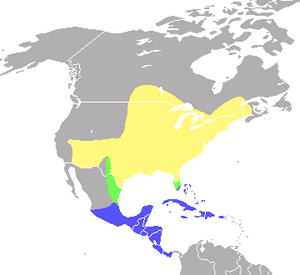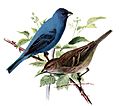Indigo bunting facts for kids
The indigo bunting, Passerina cyanea, is a small seed-eating bird. It is known for its amazing long journeys. This bird flies from southern Canada to northern Florida for breeding. In winter, it travels from southern Florida to northern South America. Indigo buntings often fly at night. They even use the stars to find their way! You can find them in farmland, bushy areas, and open woodland. The indigo bunting is a close relative of the lazuli bunting.
Quick facts for kids Indigo bunting |
|
|---|---|
 |
|
| Male (above), female (below) | |
| Conservation status | |
| Scientific classification | |
| Kingdom: | |
| Phylum: | |
| Class: | |
| Order: | |
| Family: | |
| Genus: |
Passerina
|
| Species: |
P. cyanea
|
| Binomial name | |
| Passerina cyanea (Linnaeus, 1766)
|
|
 |
|
| Range of the indigo bunting
Summer-only range Migratory range Winter-only range |
|
| Synonyms | |
|
Cyanospiza cyanea |
|
Contents
About the Indigo Bunting
The indigo bunting is a small bird. It is about 11.5 to 13 cm (4.5–5 in) long. Male and female indigo buntings look different.
Male and Female Birds
The male indigo bunting is a bright, beautiful blue in summer. This bright color helps him attract a mate. In winter, the male's feathers turn brown. The female indigo bunting is brown all year.
What They Eat
Indigo buntings change their diet with the seasons. In summer, they mostly eat insects. This helps them get enough energy for breeding. In winter, they switch to eating seeds.
Life Cycle and Reproduction
The female indigo bunting does most of the work for her babies. She builds the nest all by herself. She also sits on the eggs to keep them warm. This is called incubation.
Images for kids
-
Juvenile male indigo bunting at Smith Oaks Sanctuary, High Island, Texas
See also
 In Spanish: Azulejo índigo para niños
In Spanish: Azulejo índigo para niños





